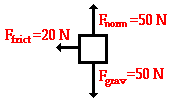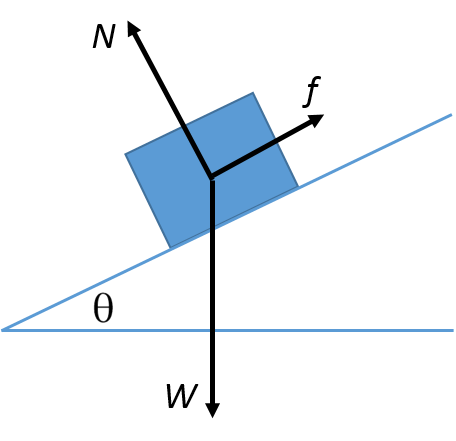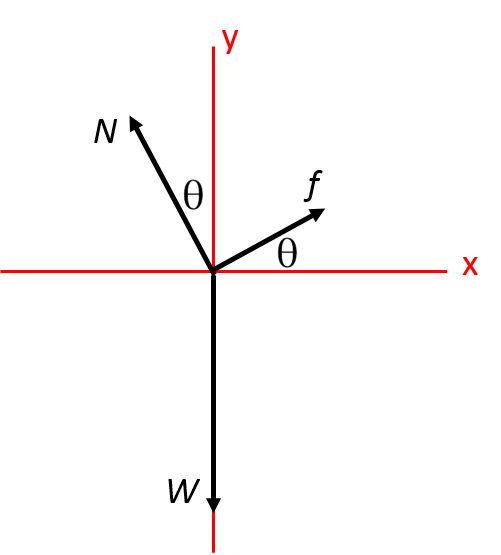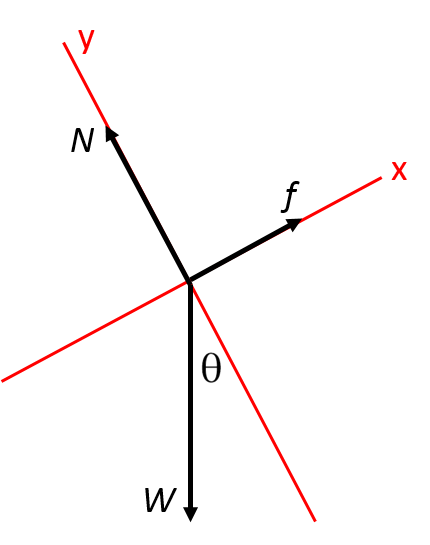Net Force
This page defines the net force acting on a system.
Main Idea
The net force acting on a system (such as a particle, collection of particles, or rigid body) is defined as the vector sum of all of the forces acting on the system. People are interested in net force because a net force acting on a system affects its motion. More specifically, it causes the system's Linear Momentum to change over time in the direction of the net force, as described by Newton's Second Law: the Momentum Principle. For a system of constant mass, this change in momentum takes the form of Acceleration in that same direction.
The effects of a net force do not depend on the forces comprising it. For example, if the forces [math]\displaystyle{ f_1 = \lt 1, 1, 0 \gt }[/math] N and [math]\displaystyle{ f_1 = \lt 1, -1, 0 \gt }[/math] N act on a system, the net force would be [math]\displaystyle{ F_{net} = \lt 1, 0, 0 \gt }[/math] N.
A Mathematical Model
In order to calculate net force, all EXTERNAL forces acting on a system are added together. The mathematical definition is
Additionally,
where m=mass of the object, and a = acceleration of the object.
If there is a nonzero net force acting on an object, that object is accelerating (not traveling at a constant velocity). A net force of zero can mean that the object is at rest, but it can also mean that the object is moving with constant velocity. Both cases have acceleration = 0, so they both satisfy [math]\displaystyle{ Fnet = m*a }[/math] because [math]\displaystyle{ Fnet = 0 }[/math] and [math]\displaystyle{ a = 0 }[/math]. It may seem strange that an object can be moving and still have net force = zero, but remember Newton's first law, which states that objects at rest tend to remain at rest and objects in motion tend to continue going the same way at the same speed unless acted on by an outside force. Imagine an astronaut has a rock that he or she throws out of the space ship while in space: the rock would float away at a constant speed and unless a meteor hit it or something, it would keep moving forever in the same direction at the same speed.
A Computational Model
Net force is an essential component of the Momentum Principle! We can use the Momentum Principle in vpython to update the position of a moving object. But first, we have to find net force.

#1 Fspring = -k*s #2 Fgravmag = mball * g #3 Fgrav = Fgravmag * vector(0,-1,0) #4 Fnet = Fspring+Fgrav #5 pball = pball + Fnet * deltat #6 vball = pball / mball #7 ball.pos=ball.pos+vball*deltat
Here, the spring force and the gravitational force are found using formulas (lines 1-3). Then, they are added together to get the net force on the object (in this case a ball, line 4). The net force is then used in the update form of the momentum principle (line 5). In line 6 the velocity is updated, and line 7 the position is updated. Without net force calculations, tracing an object's path would be impossible.
Examples
1. (Simple)
When calculating net force, it is most useful to construct a free body diagram. A free body diagram is a physical representation of the external forces applied to a system. Often, arrows are used to represent forces. In this example, forces are displayed acting on a box.
The first box is being suspended by a rope, so its free body diagram looks like this:
Assume that down is the negative y direction, and you can easily write vector representations of the forces and add them up to find the sum, which is the net force:
[math]\displaystyle{ Fnet = (0, 1200, 0) }[/math]N[math]\displaystyle{ + (0, -800, 0) }[/math]N
[math]\displaystyle{ Fnet = (0, 400, 0) }[/math]N
The second box is falling, but it has significant air resistance:
[math]\displaystyle{ Fnet = (0, 600, 0) }[/math]N[math]\displaystyle{ + (0, -800, 0) }[/math]N
[math]\displaystyle{ Fnet = (0, -200, 0) }[/math]N
The third box is on the ground and is sliding to the right, but slowing down because of friction. It has both x-component forces and y-component forces. It is important to put these in the right place in the vector coordinates.
[math]\displaystyle{ Fnet = (0, 50, 0) }[/math]N[math]\displaystyle{ + (0, -50, 0) }[/math]N[math]\displaystyle{ + (-20, 0, 0) }[/math]N
[math]\displaystyle{ Fnet = (-20, 0, 0) }[/math]N
2. (Simple)
Two external forces <60,-70,0>N and <20,10,0>N, act on a system. What is the net force acting on the system?
Answer: <80,-60,0>N
Explanation:
The net force is the vector sum of its constituent forces.
[math]\displaystyle{ \vec{F}_{net} = \vec{F}_{1} + \vec{F}_{2} }[/math]
[math]\displaystyle{ \vec{F}_{net} }[/math] = <60,-70,0)N + <20,10,0>N = <80,-60,0>N
3. (Intermediate)
There is a box, small enough to represented as a point, sitting on a slope inclined twenty degrees with respect to the horizontal. If its mass is 10 kg, what does the magnitude of the force of static friction (pointing up the hill) have to be for net force to be zero? In that case, what is the magnitude of the normal force? (All forces are measured in newtons, and the acceleration due to gravity [math]\displaystyle{ = g = 9.8 }[/math] [math]\displaystyle{ m/(s^2) }[/math]).
Let [math]\displaystyle{ f }[/math] = force of friction, [math]\displaystyle{ W }[/math] = weight of the object, and [math]\displaystyle{ N = }[/math] normal force. (The pictures are not to scale.)
First, we have to identify our coordinate axes. We could have the typical horizontal x-axis and vertical y-axis (and we know where to put [math]\displaystyle{ θ }[/math] using similar triangles):
But, that leaves us with two forces that have to be decomposed into x- and y- components. It makes more sense to draw the axes rotated twenty degrees counterclockwise, like this:
[math]\displaystyle{ W }[/math] is easy to find, since it's just mass times acceleration due to gravity, both of which are known quantities.
[math]\displaystyle{ W = mg = (10 }[/math] [math]\displaystyle{ kg)*(9.8 }[/math] [math]\displaystyle{ m/(s^2)) = 98 }[/math] [math]\displaystyle{ newtons }[/math]
Now we are ready to solve for the frictional force. It acts in the positive x direction, and we know that the net force in the x direction has to be zero, so we have to identify the other forces that act in the positive or negative x direction. In this case, it's only a component of the weight, which points in the negative x direction. Using simple trigonometry, we find that that is
[math]\displaystyle{ -W*sin(θ) }[/math]
So we can write our equilibrium equation like this:
[math]\displaystyle{ Fnetx = f - W*sin(θ) = 0 }[/math]
Then, all we have to do is solve for [math]\displaystyle{ f }[/math], since [math]\displaystyle{ W }[/math] and [math]\displaystyle{ θ }[/math] are known quantities.
[math]\displaystyle{ f = W*sin(θ) = (98 }[/math] N[math]\displaystyle{ )*sin(20°) = 33.51797405 }[/math] N, which is about equal to [math]\displaystyle{ 33.5 }[/math] N.
Now we have to solve for the normal force. It acts in the positive y direction, and we know that the net force in the y direction has to be zero, so we have to identify the other forces that act in the positive or negative y direction. In this case, the only one is the other component of the weight, which points in the negative y direction. Using simple trigonometry, we find that that is
[math]\displaystyle{ -W*cos(θ) }[/math]
So we can write our equilibrium equation like this:
[math]\displaystyle{ Fnety = N - W*cos(θ) = 0 }[/math]
Then, all we have to do is solve for [math]\displaystyle{ N }[/math], since [math]\displaystyle{ W }[/math] and [math]\displaystyle{ θ }[/math] are known quantities.
[math]\displaystyle{ N = W*cos(θ) = (98 }[/math] N[math]\displaystyle{ )*cos(20°) = 92.08987684 }[/math] N, which is about equal to [math]\displaystyle{ 92.1 }[/math] N.
Connectedness
Net force is one of the building blocks of Intro Physics, and I would assume all of physics. It's really important for all motion-related topics, specifically Curving Motion. A net force due to the gravitational pull of the Sun in the perpendicular direction is how the Earth revolves around the Sun -- why we have days and nights and years! We can see from the derivative form of the Momentum Principle that any change in momentum is due to a nonzero net force acting on a system. All changes in motion can be attributed to a net force acting in some direction.
[math]\displaystyle{ dP/dt=Fnet }[/math] ([math]\displaystyle{ P }[/math] is the symbol for momentum.)
My major is biomedical engineering, and I haven't taken any BME classes yet, but physics is a requirement so it has to be relevant. Statics is also a requirement for BMEs, and that class deals with net force in every single problem because you have to be able to analyze systems and structures based on the forces they provide and support.
History
Some of the earliest records of humans' musings about force come from Aristotle. Aristotle observed the natural world and made assumptions and equations based on what he saw. He described all motion as being either "natural"--circular and infinite OR finite, up and down, in a straight line--or "violent." Aristotle had issues with projectile motion as he could not reconcile the continuing movement of the object with the lack of force being applied. He ended up concluding that the air provides a simultaneous resistant and accelerating force to the object.
These ideas were challenged by Renaissance men such as John Philoponus, John Buridan, and Oresme, with a clear understanding of the conservation of linear momentum not arriving to the world until Descartes. The most famous face we associate with forces in Physics is Sir Isaac Newton, and he certainly played a huge role in the understanding of net force and momentum. However, he initially believed in the idea of impetus, that a projectile has a certain internal force that keeps it moving, and also the idea of transfer, that objects give up parts of their force during a collision. Though he was wrong, these ideas are not at all silly--in fact they seem quite logical--and he later corrected them after a series of experiments. Thus, the second law of motion was established and with it the relationship between force and motion.
See also
These other wiki pages might help:
Newton's Second Law: the Momentum Principle
Conservation of Momentum
Newton's Laws and Linear Momentum
External links
Physics Classroom: Net Force Physics Classroom: Drawing Free Body Diagrams
References
Cardenas, Richard. "What is Net Force? - Definition, Magnitude & Equations." Web. 30 Nov 2015. http://study.com/academy/lesson/what-is-net-force-definition-magnitude-equations.html
"Net Force." Wikipedia: The Free Encyclopedia. Wikimedia Foundation, Inc. Web. 30 Nov 2015. https://en.wikipedia.org/wiki/Net_force
The Physics Classroom. "Determining the Net Force." Web. 30 Nov 2015. http://www.physicsclassroom.com/class/newtlaws/Lesson-2/Determining-the-Net-Force
Chabay, Ruth W., and Bruce A. Sherwood. Matter & Interactions. Modern Mechanics. Hoboken, NJ: Wiley, 2011. Print.
Stinner, Arthur. "The story of force: from Aristotle to Einstein." Physics Education. 1994. Web. 30 Nov 2015. http://www.arthurstinner.com/stinner/pdfs/1994-storyofforce.pdf





